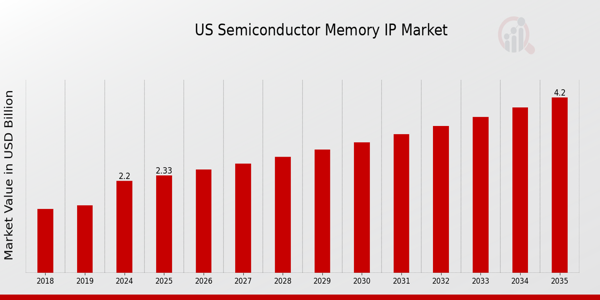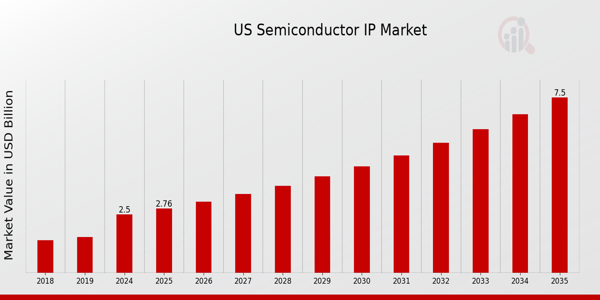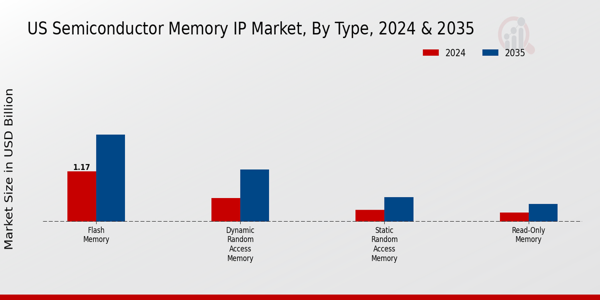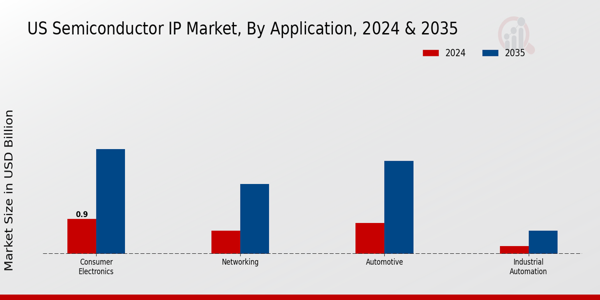US Semiconductor IP Market
US Semiconductor IP Market Research Report: By Application (Automotive, Consumer Electronics, Networking, Industrial Automation) and By Type (Microprocessor, Digital Signal Processors) - Forecast to 2035.
US Semiconductor IP Market Overview:
As per MRFR analysis, the US Semiconductor IP Market Size was estimated at 1.92 (USD Billion) in 2023. The US Semiconductor IP Market Industry is expected to grow from 2.5(USD Billion) in 2024 to 7.5 (USD Billion) by 2035. The US Semiconductor IP Market CAGR (growth rate) is expected to be around 10.503% during the forecast period (2025 - 2035).
Key US Semiconductor IP Market Trends Highlighted
The US Semiconductor IP market is experiencing significant growth driven by several key factors. The increasing demand for advanced semiconductor technologies in various sectors, such as telecommunications, consumer electronics, automotive, and healthcare, is pushing the need for specialized Intellectual Property (IP) components. As the US focuses on strengthening its semiconductor supply chain, key government initiatives like the CHIPS Act are promoting investment and innovation in semiconductor manufacturing and design. This government support facilitates collaborative partnerships between private companies and research institutions, driving advancements in semiconductor IP technologies. In recent years, there has been a noticeable trend toward the adoption of AI and machine learning algorithms in semiconductor design, allowing for faster and more efficient development of custom chips. This trend is helping to expand the range of applications for semiconductor IP in the US, creating opportunities for companies to innovate and differentiate their offerings. Additionally, the rise of the Internet of Things (IoT) is fueling the need for low-power, efficient semiconductor IP solutions, as devices increasingly connect to networks for data processing and communication. As companies focus on sustainability, there is an increasing demand for energy-efficient semiconductor designs that contribute to reduced power consumption.This trend aligns with broader environmental goals in the US. The continuous evolution of 5G technology is also influencing the market, as it requires advanced semiconductor solutions for improved connectivity and performance. These reopening trends, driven by technological evolution and government initiatives, highlight the dynamic nature of the US Semiconductor IP market, presenting opportunities for growth and development in a rapidly changing landscape.


Source: Primary Research, Secondary Research, MRFR Database and Analyst Review
US Semiconductor IP Market Drivers
Increasing Demand for Advanced Electronics and 5G Technology
The US Semiconductor IP Market Industry is experiencing significant growth due to the rising demand for advanced electronics and the rollout of 5G technology. According to the Federal Communications Commission, the number of 5G subscriptions in the US is projected to reach over 200 million by 2025, representing a substantial market for semiconductor intellectual property systems. This demand necessitates the development of complex Integrated Circuits, which in turn stimulates the need for diverse and cutting-edge Semiconductor Intellectual Property offerings.Companies like Qualcomm and Intel are heavily investing in Research and Development to create innovative semiconductor solutions, thereby driving the growth of the US Semiconductor IP Market.
Expansion of Artificial Intelligence and Machine Learning Applications
The increasing integration of Artificial Intelligence (AI) and Machine Learning (ML) across various industries is serving as a key driver for the US Semiconductor IP Market Industry. The US government has identified AI as a national priority, with an investment exceeding 1 billion USD in 2021 alone, which reflects the potential impact of AI on economic growth. This increased focus not only boosts demand for semiconductor IP designed specifically for AI applications but also leads to the creation of specialized chips for tasks like deep learning and real-time data processing.Major technology firms such as Google and NVIDIA are actively using and developing proprietary semiconductor IP to support their AI endeavors, thereby enhancing market dynamics.
Growth in Internet of Things Applications
The Internet of Things (IoT) is transforming various sectors within the US market, creating substantial opportunities for the Semiconductor IP Market Industry. A report by the US Internet of Things Consortium suggests that the number of connected devices in the US is expected to hit over 30 billion by 2030, creating a strong demand for efficient and versatile semiconductor solutions. As a result, companies focused on IoT applications, such as Texas Instruments and Broadcom, are investing in cutting-edge semiconductor IP to meet the growing requirements, thereby contributing to the overall market growth.
Increased Focus on Autonomous Systems
The rising interest in autonomous systems, particularly in the automotive sector, is a significant driver for growth in the US Semiconductor IP Market Industry. The US Department of Transportation estimates that self-driving cars could reduce traffic accidents by up to 94%, creating an urgent need for advanced semiconductor solutions responsible for operating these systems. Consequently, automotive companies like Tesla and Ford are leveraging proprietary semiconductor IP to power their driver assistance systems and a variety of autonomous features, thereby propelling the demand for such Intellectual Property in the market.
US Semiconductor IP Market Segment Insights:
Semiconductor IP Market Application Insights
The US Semiconductor IP Market has shown significant growth within the Application segment, reflecting the increasing reliance on semiconductor technology across various industries. This market environment has been driven by the rising demand for advanced semiconductor solutions that enable the development and deployment of intelligent systems, particularly in sectors such as Automotive, Consumer Electronics, Networking, and Industrial Automation. The Automotive industry has become a key driver of innovation, with a focus on electric vehicles and autonomous driving technologies that necessitate sophisticated semiconductor solutions, positioning it as a critical area within the market.Meanwhile, Consumer Electronics is constantly evolving, fueled by the demand for smarter and more connected devices, which underscores its significant influence on Semiconductor IP Market data. The rise of smart homes, wearable technologies, and high-definition displays reflects the growing importance of Semiconductor IP in everyday electronic products. Networking, driven by the increasing need for high-speed data transmission and internet connectivity, has established itself as another crucial area, pushing the demand for IP cores that enhance performance and efficiency in various networking devices.Moreover, Industrial Automation has gained traction as companies seek to enhance operational efficiency and productivity through the intelligent integration of semiconductor technologies into machinery and automation systems. The increasing focus on Industry 4.0 and the digital transformation of manufacturing processes highlight the opportunities present in this segment, contributing to market growth. Overall, the US Semiconductor IP Market segmentation hints at a dynamic landscape influenced by technological advancements and the expanding ecosystem of connected devices, which create a future ripe with potential for further growth and innovation as industries leverage these technologies to enhance their offerings.


Source: Primary Research, Secondary Research, MRFR Database and Analyst Review
Semiconductor IP Market Type Insights
The US Semiconductor IP Market demonstrates significant growth and diversification, particularly within the Type segment, which includes categories like Microprocessor and Digital Signal Processors. Microprocessors play a crucial role in the functioning of computers and mobile devices, driving advancements in technology and enhancing processing capabilities. With the increasing demand for high-performance computing and energy-efficient designs, microprocessors are pivotal in various applications, from consumer electronics to industrial equipment.Digital Signal Processors, on the other hand, specialize in processing and manipulating digital signals, becoming essential in areas such as telecommunications, audio/video processing, and automotive electronics. Their ability to handle complex algorithms at high speeds is key to the functionality of advanced technologies, such as artificial intelligence and real-time data processing. As the US Semiconductor IP Market evolves, innovations in these types not only serve specific industry needs but also indicate broader trends towards miniaturization, smarter devices, and enhanced processing power across sectors.The focus on these segments reflects the growing emphasis on integrating advanced semiconductor technologies into everyday applications, contributing to the overall market expansion and evolution. Market trends suggest that the demand for both microprocessors and digital signal processors will continue to rise as industries increasingly rely on sophisticated digital solutions.
US Semiconductor IP Market Key Players and Competitive Insights:
The US Semiconductor IP Market is characterized by a highly competitive landscape driven by rapid advancements in technology and the increasing demand for innovative semiconductor solutions. As companies strive to create more efficient and powerful chips, the landscape sees an influx of design houses, IP providers, and technology integrators. The market is defined by the need for high performance, low power consumption, and integration of complex functionalities into smaller chip designs. Companies operating in this sector are focused on enhancing their intellectual property offerings, which include various building blocks necessary for creating advanced semiconductor architectures. Competitive insights revolve around product differentiation, strategic partnerships, and investment in research and development to cater to diverse applications such as consumer electronics, automotive, and telecommunications.Cadence Design Systems holds a significant position in the US Semiconductor IP Market due to its innovative design solutions that aid in the development of complex integrated circuits. The company's strengths lie in its advanced simulation tools, robust verification capabilities, and comprehensive design and analysis software. Cadence Design Systems has built a strong reputation in the semiconductor community, establishing trusted relationships with leading manufacturers and designers. This trust is driven by their commitment to quality and cutting-edge technology, which allows clients to bring new products to market more efficiently. Additionally, Cadence's focus on integrating artificial intelligence into the design process provides an edge, facilitating the management of increasing design complexities, thus solidifying its position in this competitive market.Apple's presence in the US Semiconductor IP Market is notable as the company not only relies on external providers but also develops its own innovative semiconductor solutions, particularly in the domain of custom chips used across its product range. With key products that include the A-series chips for iPhones and iPads, as well as the M-series chips for its Mac line, Apple showcases its strength in vertical integration and custom silicon design. The company's commitment to improving performance while minimizing power consumption has set a benchmark in the industry. Apple’s strategic mergers and acquisitions help bolster its capability in semiconductor technology, enhancing its expertise in processors and other core components. The company's innovative approach and significant investment in R&D solidify its standing, allowing it to maintain a competitive edge by closely aligning hardware and software, thereby ensuring a cohesive user experience across its devices.
Key Companies in the US Semiconductor IP Market Include:
Cadence Design Systems
Apple
Mentor Graphics
Integrated Device Technology
Siemens EDA
Synopsys
Qualcomm
Nvidia
Intel
Marvell Technology Group
Broadcom
Rambus
Analog Devices
Texas Instruments
Arm
US Semiconductor IP Market Industry Developments
The US Semiconductor Intellectual Property (IP) Market has seen significant developments recently, driven by rapid technological advancements and increased demand for high-performance chips. In October 2023, Synopsys announced a collaborative effort with major tech firms, including Apple and Intel, to enhance design efficiency for next-gen semiconductor technologies. Cadence Design Systems has also experienced growth, expanding its portfolio to support artificial intelligence (AI) and machine learning applications. Notably, in September 2023, Nvidia finalized the acquisition of Arm, a key player in the semiconductor space, to bolster its capabilities in AI and mobile computing, marking a strategic consolidation in the industry. Furthermore, in August 2023, Qualcomm made strides by acquiring a smaller firm specialized in semiconductor AI solutions. The market valuation of companies like Marvell Technology Group and Texas Instruments continues to grow, reflecting strong investment due to the increasing digitalization across various sectors. This surge in demand for sophisticated semiconductor IP highlights both competitive dynamics and collaborative strategies among key players, shaping the future of technology in the US semiconductor sector.
US Semiconductor IP Market Segmentation Insights
Semiconductor IP Market Application Outlook
Automotive
Consumer Electronics
Networking
Industrial Automation
Semiconductor IP Market Type Outlook
Microprocessor
Digital Signal Processors
Report Scope:
| Report Attribute/Metric Source: |
Details |
| MARKET SIZE 2018 |
1.92(USD Billion) |
| MARKET SIZE 2024 |
2.5(USD Billion) |
| MARKET SIZE 2035 |
7.5(USD Billion) |
| COMPOUND ANNUAL GROWTH RATE (CAGR) |
10.503% (2025 - 2035) |
| REPORT COVERAGE |
Revenue Forecast, Competitive Landscape, Growth Factors, and Trends |
| BASE YEAR |
2024 |
| MARKET FORECAST PERIOD |
2025 - 2035 |
| HISTORICAL DATA |
2019 - 2024 |
| MARKET FORECAST UNITS |
USD Billion |
| KEY COMPANIES PROFILED |
Cadence Design Systems, Apple, Mentor Graphics, Integrated Device Technology, Siemens EDA, Synopsys, Qualcomm, Nvidia, Intel, Marvell Technology Group, Broadcom, Rambus, Analog Devices, Texas Instruments, Arm |
| SEGMENTS COVERED |
Application, Type |
| KEY MARKET OPPORTUNITIES |
AI-driven semiconductor design, 5G technology advancements, IoT device proliferation, Increased demand for secure chips, Custom silicon solutions growth |
| KEY MARKET DYNAMICS |
Increasing demand for AI applications, Rise of IoT and connected devices, Shortening product development cycles, Investment in R&D and innovation, Growing importance of cybersecurity solutions |
| COUNTRIES COVERED |
US |
Frequently Asked Questions (FAQ) :
The US Semiconductor Memory IP Market is expected to be valued at 2.2 billion USD in 2024.
By 2035, the market size is projected to reach 4.2 billion USD.
The expected CAGR for the US Semiconductor Memory IP Market from 2025 to 2035 is 6.055%.
In 2024, the Flash Memory segment is expected to have the largest value at 1.169 billion USD.
The market size for Dynamic Random Access Memory is anticipated to reach 1.212 billion USD by 2035.
Key players in the market include Marvell Technology, Cadence Design Systems, and Micron Technology among others.
The projected market value for Static Random Access Memory in 2024 is 0.275 billion USD.
Increased demand for high-performance computing and mobile applications are driving growth in the market.
The Read-Only Memory market is expected to grow from 0.206 billion USD in 2024 to 0.404 billion USD by 2035.
Regional trends indicate a consistent demand for advanced memory solutions in various technological applications across the US.














